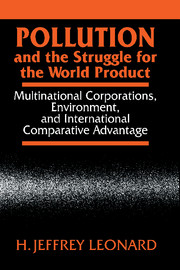 Pollution and the Struggle for the World Product
Pollution and the Struggle for the World Product During the 1970s the United States began to accumulate government regulations covering water effluents, air emissions, solid wastes, the manufacture and use of hazardous and toxic substances, and workplace health and safety. These new regulations forced industries in the United States to expend huge amounts of capital, and they induced fundamental changes in the domestic structure of many industries. As this collection of laws grew, it became obvious to economists that some industrial firms in the United States were spending more for pollution control than were firms in many other industrialized countries, and a great deal more than the modest expenditures necessary in countries outside Western Europe and Japan. The industries claimed not only that the costs of pollution abatement were high, but that the new regulations made it increasingly difficult for them to build and operate production facilities, even when they spent large amounts of money on environmental control.
As a consequence, many observers in the United States noted that the costs and logistics of complying with environmental regulations might prove a significant factor in determining the competitiveness and location of industries involved in world trade. Many policymakers, labor unions, business leaders, environmentalists, and academics expressed concern that strict domestic pollution-control standards might impair the ability of U.S. industry to compete with imported products and in foreign markets, although they proposed very different solutions to the problem. They feared that producers based in the United States would lose their comparative advantage in certain industrial sectors as a result. It was expected that many American firms, particularly multinational corporations with experience operating overseas, would respond by transferring facilities to countries where regulatory costs and encumbrances could be minimized.
To save this book to your Kindle, first ensure [email protected] is added to your Approved Personal Document E-mail List under your Personal Document Settings on the Manage Your Content and Devices page of your Amazon account. Then enter the ‘name’ part of your Kindle email address below. Find out more about saving to your Kindle.
Note you can select to save to either the @free.kindle.com or @kindle.com variations. ‘@free.kindle.com’ emails are free but can only be saved to your device when it is connected to wi-fi. ‘@kindle.com’ emails can be delivered even when you are not connected to wi-fi, but note that service fees apply.
Find out more about the Kindle Personal Document Service.
To save content items to your account, please confirm that you agree to abide by our usage policies. If this is the first time you use this feature, you will be asked to authorise Cambridge Core to connect with your account. Find out more about saving content to Dropbox.
To save content items to your account, please confirm that you agree to abide by our usage policies. If this is the first time you use this feature, you will be asked to authorise Cambridge Core to connect with your account. Find out more about saving content to Google Drive.